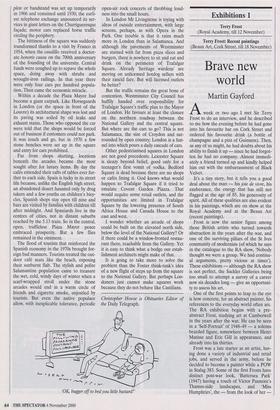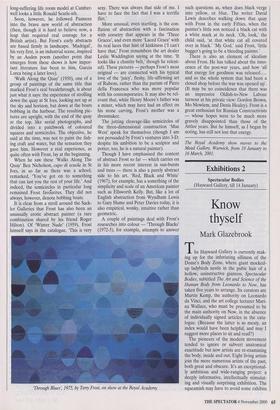Exhibitions 1
Terry Frost (Royal Academy, till 12 November) Terry Frost: Recent paintings (Beaux Art, Cork Street, till 18 November)
Brave new world
Martin Gayford
Aweek or two ago I met Sir Terry Frost to do an interview, and he described to me how the evening before he had gone into his favourite bar on Cork Street and ordered his favourite drink (a bottle of champagne and a pint of Guinness). Then, as any of us might, he had doubts about his ability to finish it up — since he had forgot- ten he had no company. Almost immedi- ately a friend turned up and kindly helped him out with the embarrassment of Black Velvet.
It's a tiny story, but it tells you a good deal about the man — his joie de vivre, his exuberance, the energy that has still not flagged at the age of 85, his generosity of spirit. All of these qualities are also evident in his paintings, which are on show at the Royal Academy and at the Beaux Art (recent paintings).
Frost is now the senior figure among those British artists who turned towards abstraction in the years after the war, and one of the surviving pillars of the St Ives community of modernists (of which he says in the catalogue to the RA show, 'Nobody thought we were a group. We had continu- al arguments, pretty vicious at times'). These exhibitions — although the RA show is not perfect, the Sackler Galleries being too small to attempt a survey of a career now six decades long — give an opportuni- ty to assess his art.
One of the first points to leap to the eye is how concrete, for an abstract painter, his references to the everyday world often are. The RA exhibition begins with a pre- abstract Frost, studying art at Camberwell in the years after the war. He can be seen in a 'Self-Portrait' of 1948-49 — a solemn bearded figure, somewhere between Henri Matisse and Eric Gill in appearance, and already into his thirties.
Frost was a late starter as an artist, hav- ing done a variety of industrial and retail jobs, and served in the army, before he decided to become a painter while a POW in Stalag 383. Some of the first Frosts have distinct post-war look, 'Battersea Park' (1947) having a touch of Victor Pasmore's Thames-side landscapes, and 'Miss Humphries', the — from the look of her — long-suffering life room model at Camber- well looks a little Ronald Searle-ish.
Soon, however, he followed Pasmore into the brave new world of abstraction (then, though it is hard to believe now, a leap that required real courage for a British artist). But Frost's early abstracts are based firmly in landscape. 'Madrigal', his very first, is an industrial scene, inspired by an Auden poem (another point that emerges from these shows is how impor- tant literature has been to him, Garcia Lorca being a later love).
`Walk Along the Quay' (1950), one of a group of paintings of the same title that marked Frost's real breakthrough, is about just what it says: the experience of strolling down the quay at St Ives, looking not up at the sky and horizon, but down at the boats bobbing in the harbour. The resulting pic- tures are upright, with the end of the quay at the top, like aerial photographs, and divided into a patchwork of coloured squares and semicircles. The objective, he said at the time, was not to paint the fish- ing craft and water, but the sensation they gave him. However a real experience, as quite often with Frost, lay at the beginning.
When he saw these 'Walks Along The Quay' Ben Nicholson, capo di scuola in St Ives, in so far as there was a school, remarked, 'You've got on to something that can last you the rest of your life.' And indeed, the semicircles in particular long remained Frost favolrites. They did not always, however, denote bobbing boats.
It is clear from a stroll around the Sack- ler Galleries that Frost has also been an unusually erotic abstract painter (a rare combination shared by his friend Roger Hilton). Of 'Winter Nude' (1959), Frost himself says in the catalogue, 'This is very sexy. There was always that side of me. I have to face the fact that I was a terrific flirt.'
More unusual, even startling, is the con- flation of abstraction with a fascination with corsetry that appears in the 'Three Graces', and even more 'Laced Grace' with its real laces that hint of kinkiness CI can't have that,' Frost remembers the art dealer Leslie Waddington saying at the time. 'It looks like a chastity belt,' though he relent- ed). These pictures — perhaps Frost's most original — are connected with his typical love of the 'juicy', fleshy, life-affirming art of Rubens, rather than the purism of Piero della Francesca who was more popular with his contemporaries. It may also be rel- evant that, while Henry Moore's father was a miner, which may have had an effect on his stone carving, Frost's mother was a dressmaker.
The jutting cleavage-like semicircles of the three-dimensional construction 'Mae West' speak for themselves (though I am not persuaded by Frost's ventures into 3-D; despite his ambition to be a sculptor and potter, too, he is a natural painter).
Though I have emphasised the content of abstract Frost so far — which carries on in his more recent interest in sun-bursts and trees — there is also a purely abstract side to his art. 'Red, Black and White' (1967), for example, has a something of the simplicity and scale of an American painter such as Ellsworth Kelly. But, like a lot of English abstraction from Wyndham Lewis to Gary Hume and Peter Davies today, it is also empirical, wonky, intuitive rather than geometric.
A couple of paintings deal with Frost's researches into colour — 'Through Blacks' (1972-3), for example, attempts to answer such questions as, when does black verge into yellow, or blue. The writer David Lewis describes walking down that quay with Frost in the early Fifties, when the painter's little son noticed a black cat with a white mark at its neck. 'Oh, look,' the child said, 'at that white cat all covered over in black.' My God,' said Frost, 'little bugger's going to be a bleeding painter.'
There is also an element of idealism about Frost. He has talked about the inno- cence of the post-war years, and how 'all that energy for goodness was released ... and so the whole system that had been a closed shop before the war was opened up'. (It may be no coincidence that there was an impressive Oldish-to-New Labour turnout at his private view: Gordon Brown, Mo Mowlem, and Denis Healey). Frost is a great enthusiast for Russian Constructivists — whose hopes were to be much more gravely disappointed than those of the Attlee years. But he himself, as I began by noting, has still not lost that energy.
The Royal Academy show moves to the Mead Gallery, Warwick, from 10 Januar)? to 16 March, 2001.



























































































 Previous page
Previous page